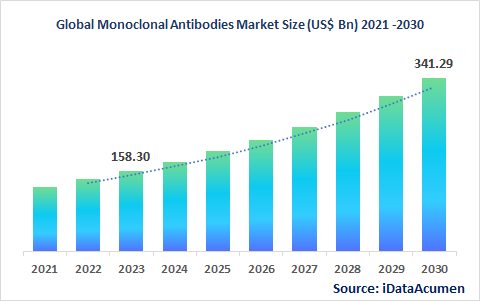Monoclonal antibodies (mAbs) are laboratory-produced molecules that are designed to mimic the immune system's ability to fight off harmful pathogens, cancer cells, or other unwanted substances. They are a type of protein that is made in a laboratory by cloning a specific type of immune cell, called a B cell. These cloned B cells produce identical copies of a single type of antibody, which is why they are called monoclonal (mono = one, clonal = clone) antibodies. The resulting mAbs can be used to target specific molecules or cells in the body, and can be used for a variety of therapeutic and diagnostic applications.
Market Drivers and Restraints:
- Increasing prevalence of rare diseases is expected to support growth of the global monoclonal antibodies market. For instance, according to Rare Genomics Institute, ~300 million people worldwide are affected by rare diseases.
- Established global organizations as well as start-up’s have introduced novel therapies for the treatment of some of the rare diseases such as Hutchinson-Gilford progeria syndrome. For instance, in January 2021, Eiger Biopharmaceuticals launched Zokinvy (lonafarnib) which is the first and only treatment available for Progeria and Processing-Deficient Progeroid Laminopathies.
However, there are certain limitations associated with orphan diseases treatment development such as limited knowledge, diagnostic capability, and limited patient pool for effective research and development. Also, high treatment costs also limit accessibility of the treatment. These factors are expected to restrain global monoclonal antibodies market growth up to certain extent.
Global Monoclonal Antibodies Market accounted for US$ 127.1 Bn in 2021 and is expected to witness a CAGR of 11.6% over the forecast period (2022-2030) to reach US$ 359.2 Bn by 2030

Competitive Landscape:
The global monoclonal antibodies market is fairly fragmented with multinational corporations and smaller companies operating in the industry. Leading companies operating in the market such as Celgene, Roche, and Novartis are offering advanced treatment options for rare diseases and are working on developing novel therapies for such diseases.
We have employed tools and techniques such as PEST analysis, SWOT analysis, PORTER’s analysis, BCG matrix to provide competitive and market intelligence.
Some of the prominent players operating in the market are:
- F. Hoffmann-La Roche Ltd.
- Pfizer, Inc.
- PTC Therapeutics
- AstraZeneca
- Novartis AG
- Takeda Pharmaceutical Company
- Bayer AG
- AbbVie Inc.
- Merck & Co. Inc.
- Bristol Myers Squibb
|
Key Insights |
Description |
|
The market size in 2021 |
USD 127.1 Billion |
|
CAGR (2021 - 2030) |
11.6% |
|
The revenue forecast in 2030 |
USD 359.2 Billion |
|
Base year for estimation |
2021 |
|
Historical data |
2017-2020 |
|
Forecast period |
2022-2030 |
|
Quantitative units |
Revenue in USD Billion, and CAGR from 2021 to 2030 |
|
Market segments |
Treatment Type, Therapy Area, Route of Administration Distribution Channel, Region |
|
Regional scope |
North America, Europe, Asia Pacific, Latin America, Middle East, and Africa |
|
Market Drivers |
|
|
Market Restraints |
|
|
Competitive Landscape |
F. Hoffmann-La Roche Ltd., Pfizer, Inc., PTC Therapeutics, AstraZeneca, Novartis AG, Takeda Pharmaceutical Company, Bayer AG, AbbVie Inc., Merck & Co. Inc., Bristol Myers Squibb |
Segments Covered in the global monoclonal antibodies market report:
The global monoclonal antibodies market is segmented based on treatment type, therapy area, route of administration, distribution channel, region as follows:
- Treatment Type (Revenue, USD Billion; 2022–2030)
- Biologics
- Biosimilar
- Others
- Therapy Area (Revenue, USD Billion; 2022–2030)
- Oncology
- Neurological Diseases
- Cardiovascular Diseases
- Infectious Diseases
- Musculoskeletal Diseases
- Hematologic Diseases
- Others
- Route of Administration (Revenue, USD Billion; 2022–2030)
- Oral
- Injectable
- Others
- Distribution Channel (Revenue, USD Billion; 2022–2030)
- Hospital Pharmacies
- Specialty Pharmacies
- Online Pharmacies
- Region (Revenue, USD Billion; 2022–2030)
- North America
- U.S.
- Canada
- Europe
- Germany
- U.K.
- France
- Italy
- Spain
- Rest of Europe
- Asia Pacific
- China
- Japan
- South Korea
- India
- ASEAN
- Rest of APAC
- North America
-
- Latin America
- Brazil
- Mexico
- Rest of LATAM
- Middle East & Africa
- Saudi Arabia
- UAE
- Rest of MEA
- Latin America